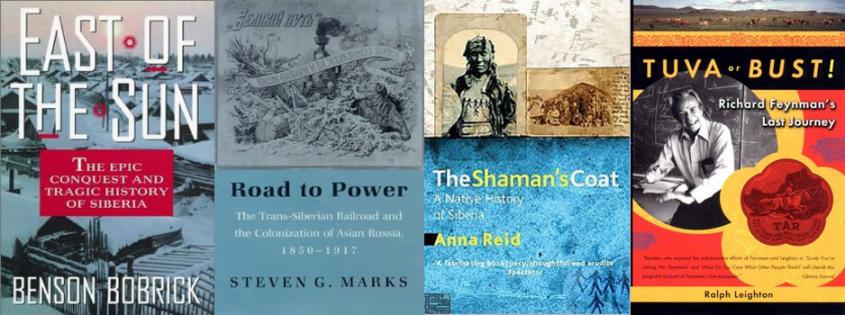Four great books and three great documentaries about the history and people of Siberia.

Benson Bobrick, East of the Sun: The Epic Conquest and Tragic History of Siberia (1992)
Bobrick’s East of the Sun is one of the most well-written and compelling narrative histories of Siberia in the broader context of Russian history. In an exceedingly accessible style, the book recounts the complex two-century process of conquest of the region by the Cossack warrior-traders, who first established Russian outposts in the 16th century. This is followed by centuries of Russian economic and cultural integration of this vast region, before and especially after the completion of the Trans-Siberian Railway. A story as tragic as it is fascinating, Siberian history is ever shaped by its richness of resources and remarkable beauty, as well as its infamous link to exile and imprisonment.
Steven Marks, Road to Power: The Trans-Siberian Railroad and the Colonization of Asian Russia, 1850-1917 (1991)
Road to Power is a fascinating political and intellectual history of the construction of Russia’s Trans-Siberian railroad at the turn of the 20th century. The book offers insights into Russian economic development in Siberia, as well as a greater understanding of the extension and contestation of Russian Imperial authority on n its most important peripheries.
Anna Reid, The Shaman’s Coat: A Native History of Siberia (2003)
Shaman’s Coat is a beautifully written account of the history of Siberia with an explicit focus on the indigenous peoples of the region, the Tuvans, Buriats, Evenkis, etc. Using her own journey through the region as a narrative thread, Reid devotes each chapter to a different Siberian ethnic group, including one on Russians, offering insights into the historical development of the region through the lens of Russian-native interaction. Finally she offers interesting impressions of the contemporary state of Siberian shamanism and native culture more broadly.
Ralph Leighton, Tuva or Bust!: Richard Feynman’s Last Journey (1991)
Tuva or Bust is a book about the extraordinary efforts of by Ralph Leighton and his teacher and friend, the prominent physicist Richard Feynman, to travel to the remote region of Tuva, then within the Soviet Union. Feynman died of cancer just before receiving his visa in 1988. The book aptly describes the culture, language and history of Tuva, including the unique phenomenon of Tuvan throat singing, in the context of this famed quest. The book is heavily referenced in the documentary film, Ghengis Blues.
Ghengis Blues (1999)
This documentary film directed by Roko Belicfocuses on the journey of American blues musician Paul Pena to the isolated Russian republic of Tuva. Pena, who was blind, became interested in Tuvan throat-singing after hearing it on shortwave radio. He taught himself to throat-sing (no easy task) over the next few years and eventually met Kongar-ool Ondar, a famous throat singer at a concert in the US. The film follows Pena’s journey to Tuva, where he sang in the triennial throat-singing festival.
Join Me in Shambhala (2002)
In Pursuit of the Siberian Shaman (2006)
Both of these documentary films, written and directed by visual anthropologist, Anya Bernstein, are focused on Buddhism and shamanism among the Buryat peoples of Southern Siberia. Join Me explores the revival of Buddhism (interwoven with local shamanism) among the Buryat peoples of the Russian Federation, as a new generation seeks training and inspiration from Tibetan masters. In Pursuit focuses on the activities of one shaman on Olkhon Island, in the middle of the famous Siberian Lake Baikal. It explores the role of the shaman among locals and tourists, interrogating the notion of the Siberian shaman as real or touristic sham.